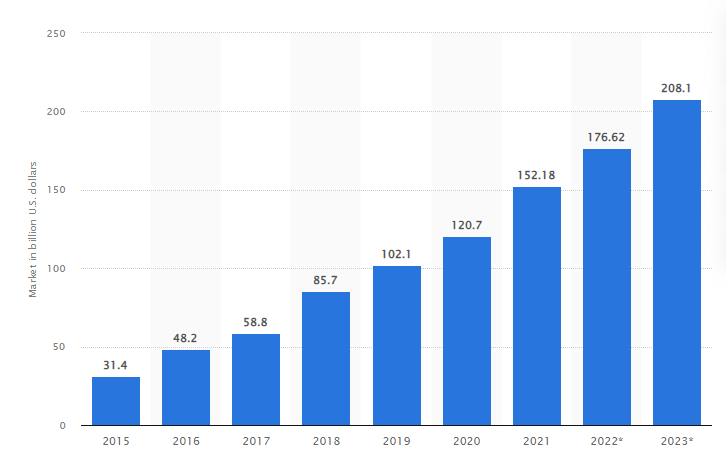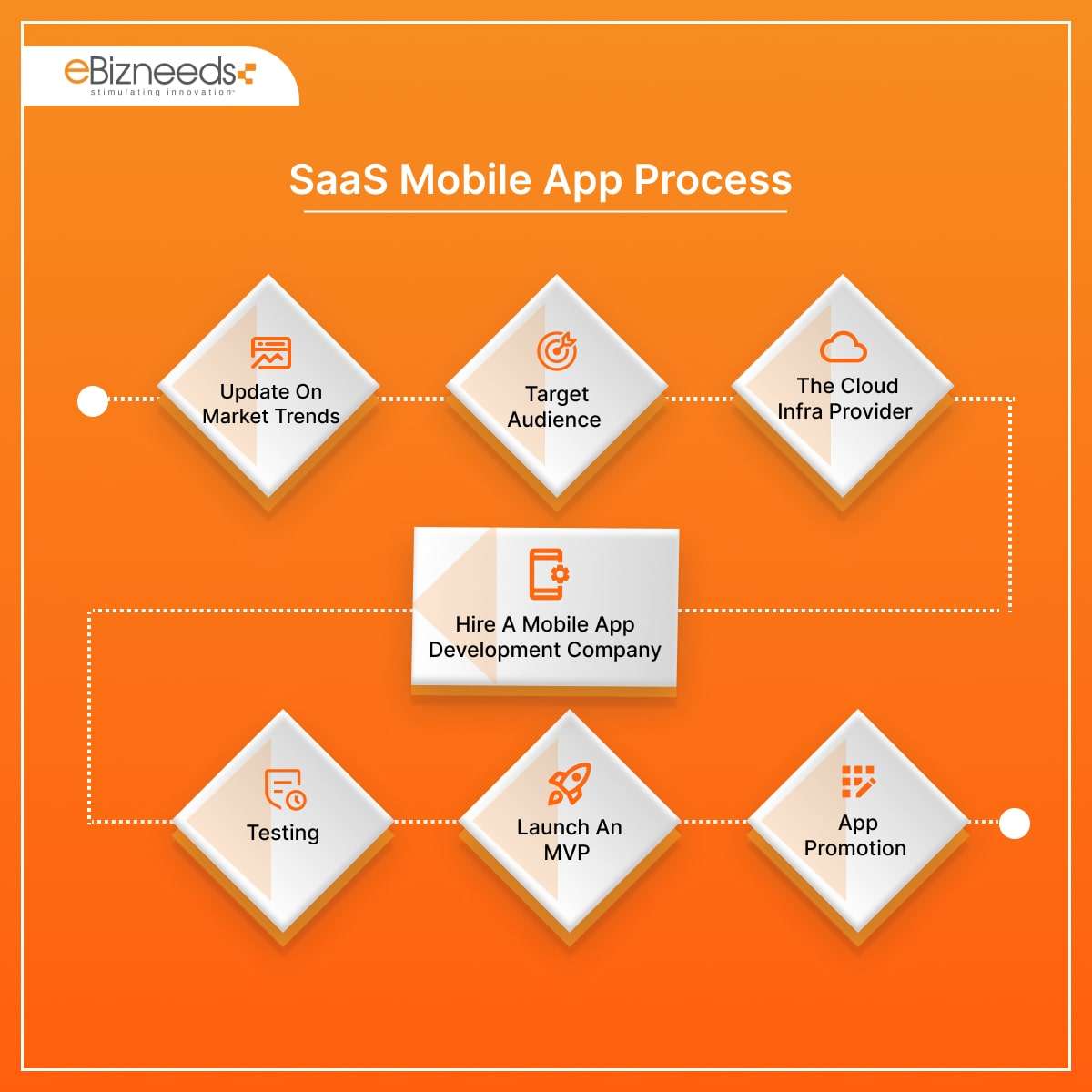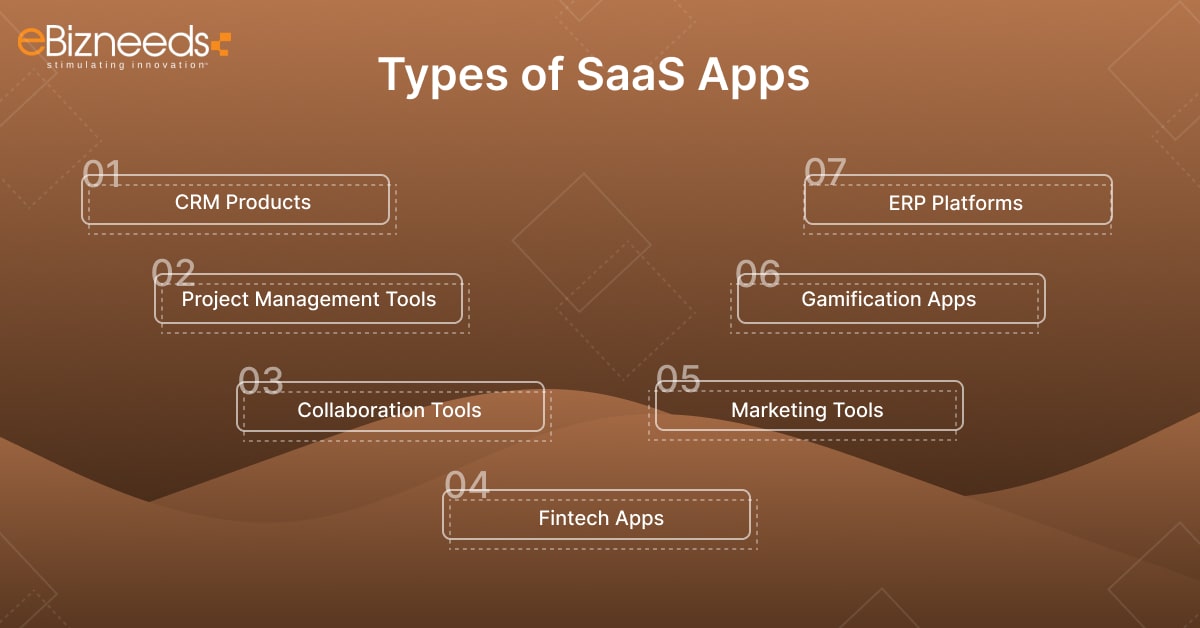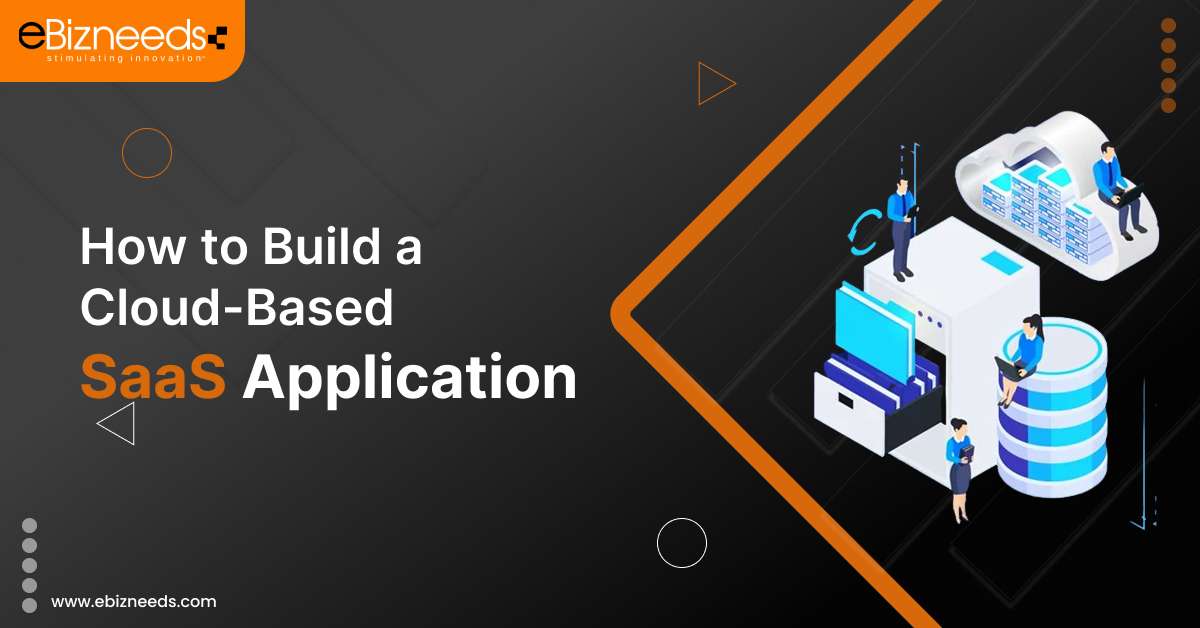Are you looking to build a Saas App for your enterprise? Or Do you want cloud-based software to achieve operational efficiency for your business?
Then yes, you are on the right path as taking the help of technology is the best way to have an extra edge in the competition. Although there are several latest technologies in the market, cloud technology-based SaaS app development is one of the leading technologies.
You will be amazed to know that by 2025 more than 80%-90% of enterprises will move to the cloud platform. Due to having several benefits, it is such a perfect technology that you can consider for developing the next business app.
Building an app for your business can be exciting and rewarding. However, it also requires considerable effort and planning to achieve your goals.
In the modern era, most businesses have moved to SaaS applications to meet their technological needs, so it’s important to find out what makes these apps so useful and how you can build one for your own business.
The ever increasing demand for SaaS mobile apps in the market has led to an increased number of business owners trying to develop their apps.
However, choosing which one to build can be quite confusing as numerous SaaS apps are available in the market, and it’s not easy to pick which one is worth developing first.
This ultimate guide on building a SaaS app will help you decide what kind of app would be best for your business and help you make your decision-making process easier.
What is SaaS App?
A Software as a Service (SaaS) application is software that is hosted on cloud computing servers and is sold as-is over an internet connection. In simple terms, you can understand it as-.
SaaS stands for Software as a Service. It is a type of software hosted on the cloud and can be accessed from anywhere with an internet connection. SaaS applications are often used in the B2B sector, but they are applicable to B2C sectors as well.
There are many benefits to SaaS applications, such as:
- Cost reduction
- Increased security
- Scalability
- Low upfront cost
- Ability to reach customers all over the world
While using SaaS applications, users need to only pay for what they use, and no expensive hardware purchases are required. Many smaller businesses and startups choose it when considering how to build a SaaS app for their business.
No need to worry about infrastructure, scaling problems, or ongoing maintenance costs if things break down; your SaaS provider will take care of all that for you.
There are several ways to build a SaaS app, but they all have one thing in common: they’re built with web technologies like HTML5, CSS3, JavaScript, and Ruby on Rails.
Many developers choose these languages because they’re relatively easy to learn, widely supported by modern browsers, and have excellent support libraries.
Most SaaS applications also require some database backend. Hence, developers often go with MySQL or PostgreSQL, which can be easily integrated into any web application framework.
To start building your own SaaS application, you’ll want to ensure you have everything set up correctly before diving in too deep.
Key Stats That You Need To Look About SaaS App Development
Before further reading this blog, I would like to mention some key statistics about SaaS apps and cloud technology. So, let’s check what these are.



- The SaaS market is expected to reach 208 billion US dollars by 2023.
- By 2023, the revenue will be 600bn USD from the public cloud market.
- One of the major security concerns for SaaS is the encryption of data within the service provider’s infrastructure.
- SaaS Revenue is projected to show an annual growth rate of 9.80% (CAGR 2022-2027), where the market volume will be US$330.60 billion by 2027.
- In 2022, the United States will be on the top regarding revenue generation worldwide, which will be $113,500 million in 2022.
- Software-as-a-service generates two-thirds of the revenue of cloud computing.
These statistics are indicating about huge possibilities in the SaaS app development sector. Continuing with the reading of this blog, let’s see about some basic information.
Why Should You Consider to Building A SaaS Application?
A SaaS application is an application that runs in the cloud and is offered to other companies as a service. This approach provides benefits to both the service provider and the end-user. It saves time, money, and resources while maintaining a competitive edge over its competitors.
There are many reasons why you should consider building a SaaS application for your business if you haven’t already. These include saving money, enhancing customer experience, improving customer relationships, and more.
Software as a service (SaaS) application is an app available on any device and can be used repeatedly. A good example of an enterprise SaaS application is Salesforce, which automates various activities in sales teams.
Other examples include Dropbox, Wrike, and Evernote, productivity apps for businesses. There are many benefits to building a SaaS app for your business: it gives you access to every platform. It leads to time management and process automation.
Furthermore, it helps you maintain your workforce as employees will have remote access from wherever they are. It’s important to note that SaaS applications take longer to build than other mobile applications due to their complexity.
Comparison of SaaS Application vs. Traditional Application
Lets’ understand the difference between SaaS and traditional apps using an example of – A popular product Adobe Photoshop which has recently adopted the SaaS model. Years ago, users need to buy Adobe Photoshop along with many other programs for a one-time price.
Once the product is purchased, users were given an unlock key to access a specific version of Photoshop for a lifetime.
However, if you try to purchase the latest version of Photoshop on Adobe’s website, you will get to know that Adobe offers its product on a subscription basis to the users.
You need to sign up for a monthly subscription instead of paying a high up-front cost and you can access the most recent version of multiple adobe products including instant updates. The monthly fee is comparatively low than that of the one-time purchase price of the old model.
Despite the pushback against the subscription way, the SaaS Application Development is on the boom because of its advantages for both developers and users.
Benefits of Building A SaaS Application
Many companies have now begun developing their software in the cloud and build SaaS applications most commonly. It is because there are several benefits of building a Saas application.
Many enterprises don’t have control over an internal IT staff that can then come up with customized software development solutions for them, which would take more time, be more expensive, and depend on how complicated their requirements are.
However, companies can either build a SaaS app for themselves or outsource it to another company to save costs and time by having instant real-time access to all information.
A SaaS application is beneficial in many ways. Firstly, it ensures that your business can grow rapidly and provides you with better flexibility. It is easy to customize and is cost-effective as well.
The main aim of any business is growth and development, and SaaS applications help you achieve that goal. This guide will provide useful information about how to build one for your business easily by hiring mobile app developers from an established software development company.
So let’s begin with the list of advantages!
#1. Cost-Effective Development
SaaS app development is cost-effective as it is one of the parts of Cloud Computing software development. It is one of the significant advantages that attracts businesses towards it. The installation cost or purchasing cost of other software is free from all costing boundations.
There is no cost associated with hardware. Here, businesses only need to pay for what they have developed with the help of SaaS application development services.
#2, Scalability In True Sense
SaaS provides scalability in a real -or true- compared to the other software development. It is a real-time scenario that, with increasing requirements then, your business will grow with time. You can easily expand your business when there is a requirement for expansion.
On the other hand, it is quite a daunting task with other types of software. It provides super flexibility to the businesses to scale with time.
#3. Time Management
In terms of time management for deploying the system, SaaS is fantastic. Software as a services-based app saves up loads of time that would otherwise have been spent on managing projects by making the work more collaborative and easy to follow.
These apps can lead to increased productivity and efficiency. The task of managing projects becomes easier with these apps that can help assign and divide tasks, track progress, and much more.
#4. Maintenance
SaaS apps are becoming increasingly popular because they are affordable, the workflows are easy to start with, and they are a lot easier to maintain. So many businesses have recognized this potential and have been developing SaaS apps to help them with business processes.
For maintaining the app, it is easy for an in-house team or for experts whom you have hired from an experienced SaaS mobile app development company.
Step-By-Step Process of Building A SaaS Mobile App From Scratch


Building a SaaS mobile app is not an easy task. Developers need to consider various points that are highly important before developing any mobile app, so it can provide services that are helpful for business owners.
These points include UI/UX designing, user experience testing, and wireframe validation, among other things. In addition, to develop mobile apps from scratch, you should take care of many tasks like hiring an app development company, selecting features and functionalities of mobile apps, etc.
Keep An Eye On The Market Trends
This point is directly connection with the research and study of the market trends. Keeping an eye on the trends can be possible after the research.
Extensive research will give you an idea of what type of trend would be better to follow for good future growth as a result of SaaS app development.
Decide Who Will Be Your Target Audience
Developing a SaaS app or software is such a fantastic thing. But for grabbing better business opportunities and onboarding the customers, it is necessary to identify the target audience.
You need to find out what type of app customers are looking for and how your app will solve their existing issues. Once you find the answer, you have won half of the battle.
The Cloud Infra Provider
Among all the crucial steps to building a SaaS app, finding a trusted cloud service provider is important. Here you need to find out a trustable and reputed vendor that can provide encryption and security, including other cloud infrastructure facilities.
It would be better to find a Cloud service provider that can help you with scalability, seamless integration, reliability, and data security.
Hire A Mobile App Development Company
Building a mobile app from scratch is not an easy task as it requires some knowledge about software development as well as design skills. But suppose you don’t have enough time or resources for such a project.
In that case, it’s better to hire dedicated developers or professionals with expertise in such a field. They can help you build your custom mobile applications within no time at all.
Testing The App’s Capabilities
Testing is one of the important aspects of any app launch. It brings out the real potential of the app. Once the app is ready, test it on the real grounds based on various test cases and testing tools.
You can also run beta testing on how users interact with the app and find out what issues users face while executing the app. Once the testing and correction are okay, launch an MVP.
Launch An MVP
Launching an MVP is always a great and smart idea. It not only helps in cost-saving but also finding out the app capabilities on real ground. Before launching a full-fledged SaaS application, you can launch an MVP that will give you real-time feedback about the app.
Later, based on the feedback, you can implement the corrections and launch the final version with full functionalities.
App Promotion
After completing all the stages of SaaS app development, it’s time to go for the app’s marketing. It is the best way to reach the target audience and generate good revenue.
For app promotion and marketing, web platform is the best. Additionally, social media marketing is also beneficial.
Types of SaaS Apps


There are a variety of apps are developed as SaaS solutions. SaaS technology is adopted by various sectors including the retail and eCommerce industry. The popular platforms to build SaaS products are Wix and Shopify in the eCommerce industry.
The SaaS solutions are comprehensive and not limited by categories. However, below we have listed the popular existing app types on the SaaS product market.
CRM Products
SaaS solutions are great to manage any organizations’ comprehensive data effectively, track all the customers’ data, run automatic marketing campaigns, offer insights and analytics, predict future growth and sales, etc.
There are a number of cloud-based CRM software vendors in the market, Salesforce is the most popular player offering apps for similar purposes.
Project Management Tools
Most organizations prefer subscribing to SaaS apps to manage workflows and various tasks such as Jira, instead of investing in purchasing a license for project management software packages.
Collaboration Tools
The popular cloud-based collaboration tool is Slack or Trello which has project management capabilities with collaboration features. The current situation has demanded web-based video conferencing platforms like Zoom.
Zoom is a popular app that is used for both personal and business communication. These cloud-based collaboration tools allow users to run in-person meetings in a virtual environment.
Fintech Apps
Cloud computing services also help you with billing and financial transactions. Cloud-based billing services such as Stripe have various features and can combine merchant accounts with payment gateways and manage subscriptions effectively.
Marketing Tools
Marketing is an important aspect of a business. SaaS apps are helping business boost their marketing efforts. Software like Microsoft Dynamics 365 is popular cloud-based apps to promote business. The number of marketing tools is increasing day by day in the market.
Gamification Apps
Enhancing productivity via gamification is getting popular nowadays. Gamification apps help to increase productivity and engagement. A gamification SaaS app is available both in Android and iOS versions.
ERP Platforms
Web-based solutions are also taking place of traditional enterprise apps. Powerful ERP platforms such as SAP include dashboards and data analytics that allow businesses to have insights into their operations.

Features you must Consider when Building SaaS Apps
There are some common features that SaaS products must have irrespective of any industry. If you are looking to develop SaaS solutions, here is the list of the basic required features.
Functional Features
Functionality is one of the most important aspects of the software. These features are the primary reason for using your app. For example, the function of the Zoom app is to allow users to video-conferencing, conducting meetings in a virtual environment.
Another app Canva helps users to create attractive graphics using customizable templates.
Data Analytics
The latest web development trend is using analytics tools in SaaS solutions. Data analytics tools help users gain insights into a number of reports and dashboards about the success of their business efforts, latest trends, and so on.
Marketers may probably use analytics tools to track user behavior patterns and check the success of the campaigns they run.
Tools for Managing User Roles
The SaaS solution includes a variety of access layers. Therefore it becomes essential to integrate tools for managing user roles. For instance, in Clubhouse, users may play the role of Speakers, Listeners or Moderators, and the user roles are completely different.
Challenges You May Face When Building SaaS App
The above-discussed app development steps are clear and simple, however, there are some tech difficulties that you have to face when developing cloud-based apps. Some of the challenges are:
Multi-Tenancy
The SaaS apps serve the needs of multiple users at the same time. Cloud-based SaaS architecture apps should include multi-tenancy no matter what industry app you are building. Since there is common access, security becomes the prime concern.
Developers just need to implement proper measures to stop users (tenants) from accessing other users’ data.
Customization
SaaS apps are designed for a wide variety of businesses and user categories, so they must be flexible and configurable to adapt to different user needs. Users should also allow customizing the app for a better and enhanced personalized experience.
Scalability
With time as businesses grow, the need also grows to handle more data and users. So, the web apps you build should be developed accordingly and able to scale on-demand to handle more users or increased data and processes. The great scalable app is the one that has zero downtime.
Connect ability
SaaS app must have third-party APIs so that the app can be connected to any other platform or service used by the organization. It is very important to have the connectivity into SaaS architecture as you begin with app development because the platform works along with other apps and systems.
It is certainly a bit tricky to ensure security, scalability, and integration in your SaaS app; therefore it is significantly important to choose a cloud infrastructure provider wisely.
On the other hand, it is also very essential to choose the tech stack with the utmost consideration of all the factors that impact the SaaS app.
Choose Right Technology for your Cloud-Based SaaS Product
Choosing the best technology is a very important aspect. As per the latest trends and technology, the most popular and widely used technology in SaaS development is:
Frontend
The most popular languages for front-end development are HTML, Javascript, and CSS, and common frameworks are Angular and React to build a web app.
Backend
When choosing a programming language for backend development, you have the recommended choices like Python, PHP, JavaScript, and their native development environments.
Backend storage
When choosing a perfect database for storage management MySQL, MongoDB, or PostgreSQL are recommended. And when it comes to choosing servers, Apache or Nginx is recommended.
The Final Thoughts
It’s very tough for you as a start-up. I know what you are thinking at first. How can I build a SaaS app? But, there is no need to worry about that. You don’t have to hire expensive developers who charge thousands of dollars per month to develop your software.
There are companies out there that do not just offer cost-effective SaaS application development services but also help you promote your app so that you can get attention from customers and other users on a wider scale.
They’ll work with you one-on-one throughout the entire process of developing your Saas application. You’ll also get excellent customer support and regular updates, so there are no surprises at launch time!



Naveen Khanna is the CEO of eBizneeds, a company renowned for its bespoke web and mobile app development. By delivering high-end modern solutions all over the globe, Naveen takes pleasure in sharing his rich experiences and views on emerging technological trends. He has worked in many domains, from education, entertainment, banking, manufacturing, healthcare, and real estate, sharing rich experience in delivering innovative solutions.






